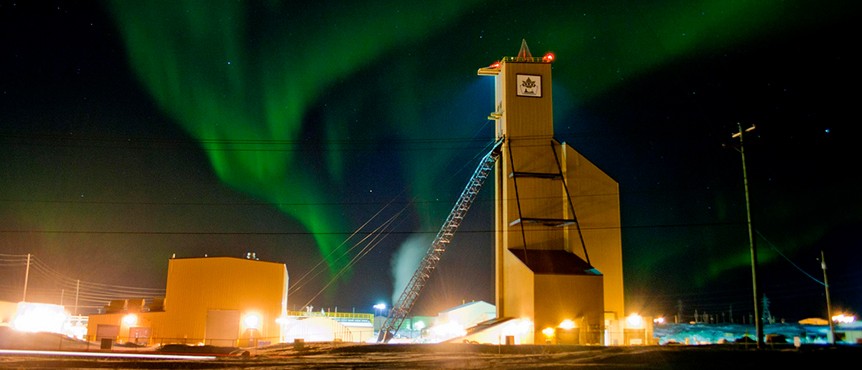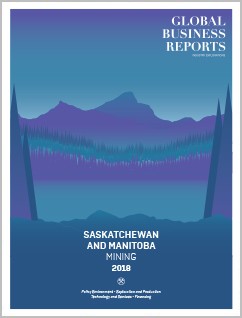Manitoba lacks advanced exploration projects, meaning a lag in traction and new mine development in the foreseeable future, but with a continued focus from the government and an uptick in mining investment, the province has all the makings for success in the longer-term.
RELATED PUBLICATION
ARTICLES FROM THIS PUBLICATION
Manitoba’s Exploration Potential

IMAGE: Courtesy of Hudbay Minerals
Manitoba’s potential for clean energy resources, which have high demand projections, make it an attractive prospect for new exploration ventures. “Manitoba has very exciting mineral potential in zinc, nickel, copper, gold, diamonds and lithium,” underlined Andrea McLandress, executive director at the Mining Association of Manitoba. “Today, the federal government wants to push the transition towards clean energy technologies, while China is promoting the big switch to renewable energy and electric vehicles. All the main components can be found in Manitoba: copper, zinc, nickel and lithium. We want to promote a vision of 'Manitoba mining for clean energy technology'. It is a very exciting message for investors as well as for our own local and indigenous communities.”
Toronto-based Far Resources is one company following this route at its Zoro project, located near Snow Lake. The company has now conducted two campaigns, with a third imminent. “What is really exciting about this project is not just the fact that we have seven dykes, it is that we are in a pegmatite field,” commented Keith Anderson, Far Resources’ president. “Some pegmatite projects have just one big pegmatite dyke – here, we have a whole field. There is a lot of overburden cover, so we do not even know what is underneath that. There could be bigger pegmatite underneath, so we decided to do a geochemical sampling program to evaluate the likeliness of that.”
The 2018 drill program will follow up on these other dykes that may be covered, and Far Resources has increased its land package from 500 hectares to 2,200 hectares in anticipation.
Mustang Minerals is also hoping to access this corner of the market with its combined operation from two open pits, Mayville (copper-nickel) and Makwa (nickel-copper). Its last major study was a preliminary economic assessment but, due to the cycle, the company has been underfunded for the past couple of years. However, Robin Dunbar, Mustang Minerals’ president, maintains a positive outlook going forward. “Most people have a forecast for the price of nickel of US$7 to US$7.50/lb which, coupled with the current strong US dollar, puts us at the level of our existing PEA,” commented Dunbar. “We have been disappointed by fundamentals many times in the past, but nickel fundamentals look very good right now. Also, if you look around, there are not many nickel projects. Whenever the price of nickel goes up, we see strong attention directed at our company, because we have a doable project. Now, our goal is to drive the break-even of the project down significantly and move towards a pre-feasibility study.”
Referring to increased demand for electric vehicles, Dunbar highlighted: “According to some forecasts, by 2025 between 300,000 and 900,000 mt/y Ni will be used in battery technologies. That nickel comes from sulphide nickel which is transformed into nickel sulphate –all the pig nickel that comes from laterite deposits cannot be used for the production of batteries. Current supply of sulphide nickel is 1.3 million mt/y and is declining, so that is the supply that will be needed for batteries moving forward.”
Precious Metals: Deserving Attention
Whilst base metals have put Manitoba on the map, precious metals have been relatively underexplored. “It is because the original discoveries, such as the Flin Flon deposit, were base metals and they were very large,” remarked Gorden Glenn, chairman, president and CEO, Minnova Corp.
A feasibility study has just been completed on Minnova’s PL gold deposit in central Manitoba, a re-start from a past producing mine in the 1980s. The project should produce 50,000 oz/y and up to 70,000 oz/y with the expansion potential. “The project is very robust with a high IRR of over 50% and relatively low capex of approximately C$35 million. This contributes to a very short payback of approximately 1.5 years. The capex is low because we have a 1,000 mt/d mill that is in very good condition considering it has not been used for 30 years,” continued Glenn.
Another project with significant potential is Altius’ Lynx Diamond project. In partnership with a group of prospectors and geologists, the Manitoba Geological Survey found diamonds in the outcrop. “It is an enigmatic system, in part because it is probably the oldest diamond occurrence in the world (2.7 billion years old),” explained Lawrence Winter,
VP exploration at Altius Minerals. “It is not a kimberlite per se, so it is not like most diamond deposits at all. It is such a voluminous sequence that the potential for a bulk tonnage deposit is significant. A comparable situation in the copper business would be a porphyry deposit.”
Altius, established 20 years ago, is a prospect generator that generally seeks to leverage projects by bringing in partners, never taking a project to the development stage on its own. Whilst Altius is widely recognized as a royalty company, its Lynx Diamond project in Manitoba is one of more than 30 projects in its exploration business unit.
Alamos Gold is likely to have the next producing mine in the province with its Lynn Lake gold project, a highly prospective past-producing gold camp. Previously a joint venture between AuRico Gold and Carlisle Goldfields, Alamos Gold merged with AuRico Gold in 2015 and consolidated full ownership of Lynn Lake in January 2016 through its acquisition of Carlisle Goldfields. The project consists of two primary deposits: the MacLellan mine and the Gordon mine, which were the subject of a positive feasibility study published in December 2017. The study declared an initial proven and probable mineral reserve of 26.8 million mt grading 1.89 g/t Au, containing 1.6 million ounces of gold. Both deposits will be developed using conventional shovel/truck open pit mining methods. Average annual gold production is projected to sit at 170,000 ounces over the first six years and 143,000 ounces over the first 10 years, with life of mine production of 1.5 million ounces. The Gordon and MacLellan deposits are expected to operate concurrently for the first six years of operation, with Gordon to be depleted first given its higher grades and lower stripping ratio. As the Gordon pit nears depletion, mining equipment will be transferred to MacLellan and utilized over the remainder of its mine life.
Waiting for Take Off
With a clear message from the government in place and proven resource potential, attracting investment and driving exploration are the next steps for the province in fostering a strong mining sector. “We are coming out of nearly two decades of NDP government, and the new conservative government is focused on promoting business,” highlighted Norman Snyder, managing partner at Taylor McCaffrey LLP. “If the carbon tax is an issue here, it is because we are dealing with it now; at least we will have some certainty about the taxation framework that other provinces do not have. We expect to see more support for businesses, but it is a big task – the ship cannot be turned overnight.”
However, while many of the pieces of the puzzle are in place, Manitoba lacks advanced exploration projects, meaning a lag in traction and new mine development in the foreseeable future. Nevertheless, with continued focus from the government and an uptick in mining investment imminent, the province has all the makings for success in the longer-term.











